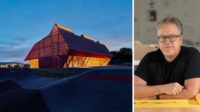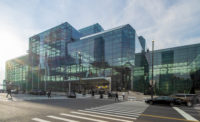Budapest, Hungary
L'szl' Bencz'r, P'ter Sug'r, L'szl' Kara
Like moonlight on the water, Lánchíd 19 captures the shimmer of the Danube coursing through Budapest. Tucked at the base of the hill below Buda Castle on a leafy avenue overlooking the river, the six-month-old hotel evokes the famous waterway with a dynamic facade of 150 rectangular glass lamellas. Arranged six to a window, the lamellas rotate on chain-driven servomechanisms. Each lamella is screen printed with multicolored pixelated patterns and sandblasted on the opposite side for texture, and reflects a panel of six LEDs embedded in the window sill.
A large, integrated design team treated the river-facing elevation as a single surface, with each lamella wired into a central network that responds to temperature and wind signals from roof-mounted sensors, says member architect László Benczúr. “The whole facade moves slowly when the weather is quiet, and faster when it is windy.” Color patterns and shades of each hue are programmed to change subtly with time and temperature. Guests can control their rooms’ six panels, and after 2 hours the sensor system overrides the signal, moving back to a unified windowpane choreography.
Duna Resort, a Hungarian property developer, initiated the $10 million Lánchíd 19 project in 2004. Benczúr competed against architects Péter Sugár and four others; in the end, the competition committee recommended that Benczúr and Sugár work together. The pair, along with architect László Kara, then assembled an ad hoc team, including local studios Szövetség 39, Hidromatic, and Nextlab, to design, engineer, and program the interactive facade. Fashion designers USE supplied the hotel uniforms, and the client commissioned DEFO to decorate the room interiors.
The result is a compelling, seven-story, 45-room building characterized, like its facade, by an extensive deployment of glass and light, with a glass atrium bringing daylight to the interior, glass bridges leading to guest rooms, and a glass-and-steel staircase linking the foyer to the hotel restaurant. Glass floors in the lobby expose the Roman-era foundation ruins found and left untouched during the building’s excavation, and in the guest rooms, glass partitions separate living spaces from the bathroom.
“The functional structure of the public spaces is the most important and spectacular element of the building,” Benczúr says. “The atrium rises the full height of the building, connecting the ground floor, the entrance lobby, the garden, the restaurant bar, and the corridors with the glass roof.”
In that spirit of forging connections, the interactive facade, which the architects call Homo Lumens, expresses the communication between the structure and its surroundings. The pixels on the glass lamellas are actually small images of butterflies, fish, and plankton that interlock into larger patterns as these panels shift. Passersby see multiple objects at once: knights or bottles when looking closely, or moving water or clouds when they soften their focus. “The idea was motion controlled by the weather,” Benczúr says. And like the currents of the Danube moving in concert, so these representations move across the building in the same downstream motion as the river.
The programming, done by Nextlab, recalls the sophisticated lighting programs now used by big nightclubs, where every light can be adjusted and directed against an overarching program. Each set of six glass panels is controlled separately by two chain-driven servos, which arrange the lamellas into bigger pictures. In a similar way, the whole structure fits together with disparate pieces receiving and sending multiple signals, delighting different viewers and points of view.


